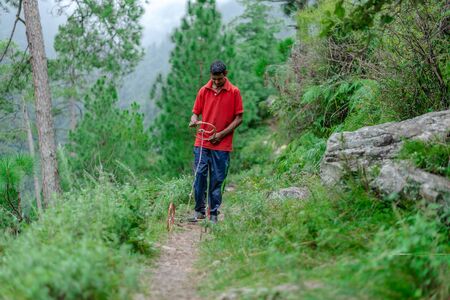Introduction to the Pennine Way
Discover the rich history and significance of the Pennine Way, Britains very first National Trail, and why it remains a cherished adventure for walkers across the UK. The Pennine Way is more than just a path—it’s a journey through the heart of England’s upland landscapes, stretching from Edale in Derbyshire all the way to Kirk Yetholm on the Scottish border. Officially opened in 1965, this iconic trail was inspired by America’s Appalachian Trail and has since become a rite of passage for ramblers seeking both challenge and tranquillity. Its creation marked a turning point in public access to Britain’s countryside, fostering a deep appreciation for the wild beauty of the Pennines—the so-called “backbone of England.” Today, families, solo adventurers, and seasoned hikers alike are drawn to its windswept moors, dramatic peaks, and welcoming villages. Whether you’re after a bit of fresh air or planning a life-changing trek, the Pennine Way offers everyone a chance to step into Britain’s walking heritage and experience some of the most breathtaking vistas our nation has to offer.
2. Planning Your Pennine Way Adventure
Tackling the Pennine Way is a truly rewarding experience, but a bit of British-style planning goes a long way to ensure your trek is memorable for all the right reasons. Here’s how to set yourself up for success on Britain’s first National Trail.
Best Times to Walk the Pennine Way
The British weather has a reputation of its own! The ideal time for most walkers is late spring through early autumn. Here’s a quick guide:
| Season | Pros | Cons |
|---|---|---|
| Spring (April–June) | Wildflowers in bloom, fewer crowds | Unpredictable showers, cooler temperatures |
| Summer (July–August) | Longest daylight hours, warmer weather | Busier trails, midges in the north |
| Autumn (September–early October) | Stunning colours, quieter paths | Shorter days, risk of rain increases |
| Winter (November–March) | Dramatic scenery, solitude | Difficult conditions, limited facilities open |
Route Planning Essentials
The full Pennine Way stretches over 268 miles from Edale in Derbyshire to Kirk Yetholm just over the Scottish border. Most families or casual walkers opt for one or two sections at a time. Consider your group’s fitness levels and time available before deciding your starting point and daily distance. The National Trails website offers detailed maps and stage suggestions to help you plan each leg.
Securing Accommodation Along the Trail
B&Bs, cosy inns, campsites, and youth hostels pepper the route, but they can book up quickly—especially in high season or school holidays. Always reserve ahead where possible. Many accommodations offer packed lunches or drying rooms for soggy kit—a real treat on rainy days!
Packing the British Way: What to Bring
- Waterproofs: A proper waterproof jacket and trousers are essential; British rain doesn’t muck about.
- Layered Clothing: Weather can change faster than you can say “cuppa.” Layers let you adjust quickly.
- Ordnance Survey Maps: Even with GPS, having paper maps is wise. The OL1–OL43 Explorer series covers the whole trail.
- Sensible Footwear: Sturdy boots with ankle support are a must—think mud and moorland bogs!
- Midge Repellent: Particularly handy in northern sections during summer months.
- Brew Kit: Nothing says “British” like a flask of tea for those well-earned breaks.
- Cake or Biscuits: For morale-boosting pit stops along the way!
A bit of thoughtful preparation makes all the difference and ensures your Pennine Way adventure is as enjoyable as it is unforgettable—no matter what the Great British weather brings.

3. Highlights Along the Pennine Way
If you’re planning an adventure along the Pennine Way, you’re in for a treat when it comes to memorable sights and friendly local encounters. This iconic trail stretches through some of Britain’s most beloved landscapes, offering plenty of must-see highlights for walkers of all ages.
Yorkshire Dales: Rolling Hills and Stone Villages
The Yorkshire Dales is often described as the heart of England’s countryside. As you walk through gentle, rolling hills dotted with dry-stone walls and sheep, you’ll pass through charming villages like Malham and Horton-in-Ribblesdale. Don’t miss Malham Cove—a dramatic limestone amphitheatre—and the lovely Aysgarth Falls, both perfect spots for a family picnic or a well-earned rest.
Pennine Moors: Open Skies and Heather-Clad Beauty
The open moorlands are where you truly feel the wild spirit of the Pennines. The vast stretches of heather are particularly stunning in late summer when they burst into purple bloom. It’s not uncommon to spot curlews or hear skylarks overhead as you cross these tranquil spaces. Community-run pubs and cosy tearooms in places like Hawes and Dufton offer a warm welcome after a day on your feet.
Hadrian’s Wall: Stepping Back in Time
No journey along the Pennine Way would be complete without visiting the legendary Hadrian’s Wall. This UNESCO World Heritage Site weaves together Roman history and scenic grandeur. Walk alongside ancient stones that once marked the edge of an empire, and let your imagination wander as you take in panoramic views across Northumberland National Park.
Northumberland: Dramatic Vistas and Friendly Faces
As you head further north, the landscape becomes even more dramatic—think rugged hillsides, sweeping valleys, and wide-open skies. In Northumberland, you’ll find some of the trail’s most spectacular scenery, especially around Bellingham and Byrness. The local communities here are known for their warmth; don’t be surprised if you’re greeted with a friendly “Howay!” or invited in for a cuppa by locals who love sharing stories about their patch of Britain.
Infused with Local Character
What truly makes walking the Pennine Way special isn’t just its natural beauty—it’s the character and generosity of those who call these hills home. From village shops selling homemade cakes to family-run B&Bs eager to share tips about the trail, there’s a genuine sense of community spirit everywhere you go.
Perfect for Families
Whether you’re travelling solo or bringing the whole family along, there’s something on the Pennine Way for everyone. Scenic picnic spots, easy detours to local attractions, and plenty of opportunities to meet fellow walkers make every mile memorable. So lace up your boots, keep your eyes peeled for hidden gems along the way, and get ready to discover why this national trail has captured so many hearts across Britain.
4. Navigating the Trail: Safety and Support
The Pennine Way is a cherished route among walkers, but British weather and rugged terrain call for a bit of classic caution. Whether youre embarking with your family or setting off solo, understanding how to navigate safely is key to enjoying Britain’s first National Trail.
Trail Markings and Maps
The Pennine Way is marked by distinctive acorn symbols along stiles, gates, and signposts. However, in remote stretches, markers can be sparse or obscured by weather. Always carry an up-to-date Ordnance Survey map and a reliable compass (or GPS device). Don’t solely rely on your mobile – signal can be patchy across the moors.
| Navigation Aid | Where to Use | Tip |
|---|---|---|
| Acorn Signs | Most established sections | Watch out for faded markers in poor weather |
| Ordnance Survey Maps (OL1, OL2, OL21) | All sections | Laminated maps withstand rain better |
| GPS Device/Apps | Remote moorland & hills | Download offline maps in advance |
Weather Expectations: Prepare for All Seasons
The Pennines are notorious for sudden changes in weather—sunshine can turn to drizzle or even sleet within hours. Always check the Met Office forecast before setting off each day. Pack layers, waterproofs, and spare socks – dry feet are happy feet! Families should plan for extra stops and shelter options if little ones get cold or tired.
Typical Weather Challenges Along the Pennine Way
| Section | Common Hazards |
|---|---|
| Kinder Scout to Haworth | Boggy paths, mist, strong winds |
| Pennine Bridleway Crossings | Muddy tracks, sudden showers |
| Cumbrian Hills | Low visibility, cool temperatures year-round |
Valuable Resources: Support for Walkers
- Pennine Way Association: Offers route updates and advice.
- Youth Hostels & Bunkhouses: Family-friendly stays dotted along the way.
- Mountain Rescue: Dial 999 in emergencies; always leave your planned route with someone trustworthy.
- Pubs & Village Shops: Perfect for a hearty meal or replenishing snacks – also great places to gather local advice.
- Cairns & Bothies: Provide basic shelter if caught out in bad weather.
A Final Word of British Caution
No matter how seasoned you are, respect the trail and its wild nature. Double-check your kit before each stage and never underestimate British fog or rain. With a little preparation and some good old-fashioned common sense, everyone—from families with children to solo adventurers—can enjoy the Pennine Way safely and make lasting memories along the backbone of England.
5. Family Walks and Dog-Friendly Tips
The Pennine Way isn’t just for hardened hikers—it’s a brilliant destination for families seeking adventure with their children and canine companions. Here’s how to make the most of Britain’s first National Trail with the whole family in tow, ensuring everyone enjoys a proper British day out.
Family-Friendly Sections of the Pennine Way
While the full trail stretches for 268 miles, several sections are ideal for shorter, family-friendly strolls. The area around Malham Cove offers a gentle walk with spectacular limestone scenery—children will love exploring the natural amphitheatre and spotting local wildlife. Near Edale, the start of the trail, you’ll find circular walks such as the route to Jacob’s Ladder, which is manageable for youngsters and offers rewarding views. For those near Yorkshire, the stretch between Hawes and Hardraw Force is perfect for a leisurely outing, ending at England’s highest single-drop waterfall—a real treat for curious little explorers.
Dog-Walking on the Trail
The Pennine Way welcomes well-behaved dogs, but it’s wise to keep your furry friends on a lead, especially when crossing farmland or during lambing season. Many stiles along the way are dog-friendly, though some larger breeds may need a helping hand over obstacles. Always bring water and snacks for your four-legged pals, and be prepared to clean up after them—keeping the countryside pristine for everyone.
Local Amenities for Families
You’ll find plenty of cosy pubs and tearooms along popular sections of the trail, many of which are happy to welcome muddy boots—and paws! The Old Nags Head in Edale and The White Lion Inn at Hebden Bridge are both known for their hearty fare and relaxed atmosphere, making them perfect pit stops for refuelling after a morning’s walk. Look out for village shops selling locally made treats—ideal for picnics or rewarding good behaviour.
Best Picnic Spots Along the Pennine Way
No British family outing is complete without a picnic hamper. Scenic spots like Brontë Waterfall near Haworth or the open moorland above Marsden offer sweeping views where you can spread out a blanket and enjoy sandwiches (don’t forget the crisps!). By Malham Tarn, there are grassy banks perfect for paddling feet—or paws—in summer. Remember to leave no trace behind so others can enjoy these beautiful spaces too.
With its mix of accessible routes, welcoming amenities, and unforgettable landscapes, the Pennine Way is a fantastic choice for families looking to make lasting memories together—two-legged or four!
6. Local Culture, Food and Hospitality
One of the true highlights of walking the Pennine Way is experiencing the rich local culture and authentic British hospitality that define this legendary trail. As you journey through charming villages and historic market towns, you’ll find yourself welcomed with open arms by friendly locals who take great pride in their communities.
The Heart of the British Pub
No trip along the Pennine Way would be complete without stopping at one of its many traditional pubs. These cosy establishments are much more than just places to eat and drink—they are social hubs where hikers, farmers, and villagers gather to share stories and laughter by a crackling fire. Whether you’re enjoying a hearty Sunday roast or a classic Ploughman’s lunch, you’ll soon discover why the British pub is an institution cherished across generations.
Savouring Regional Delicacies
The Pennine Way passes through regions known for their distinctive foods. In Yorkshire, treat yourself to a slice of famous Wensleydale cheese or sample a comforting Yorkshire pudding. Venture into Lancashire for a taste of its celebrated hotpot, and don’t miss the opportunity to try Bakewell tart if your journey takes you near Derbyshire. Locally-sourced ingredients are proudly used in most eateries along the route, offering fresh and flavourful meals to satisfy any appetite after a long day’s walk.
Warmth from the Locals
Hospitality along the Pennine Way is as memorable as the landscape itself. Many family-run B&Bs and guesthouses welcome walkers with tea, homemade cake, and helpful advice about the next leg of your adventure. You’ll find that even in the smallest hamlets, locals are eager to share tales about their area’s history, legends, and hidden gems—making every stop feel like a home away from home.
Family-Friendly Experiences
If you’re travelling with children, there’s plenty to keep everyone entertained. From village fêtes featuring traditional games to farm shops selling local produce and treats, families can immerse themselves in rural British life together. The relaxed pace and genuine kindness encountered on the Pennine Way make it an especially welcoming destination for walkers of all ages.
In short, embracing local culture, food, and hospitality is an essential part of your Pennine Way experience—one that will leave lasting memories long after your boots have been cleaned and put away.
7. Wrapping Up: Practical Advice and Lasting Memories
As you reach the end of this comprehensive guide to the Pennine Way, it’s time to reflect on how to make your journey as rewarding as possible—both for yourself and the beautiful British countryside that hosts your adventure.
Leave No Trace: Respecting Britain’s Natural Heritage
One of the core values on any UK national trail is to leave no trace. The Pennine Way traverses some of England’s most treasured landscapes, from wild moors to charming villages. Be sure to take all rubbish with you, stick to marked paths to protect delicate habitats, and be considerate of wildlife and local livestock. These small acts of respect preserve the trail for future generations and ensure everyone can enjoy its unspoilt beauty.
Cherishing Family Moments Along the Trail
The Pennine Way isn’t just about reaching a destination—it’s about creating memories with those you love. Whether you’re walking with children or grandparents, take the time to pause at scenic viewpoints, share a flask of tea on a windswept hilltop, or snap photos beside iconic waymarkers. These shared experiences become family stories that are recounted for years to come.
Practical Tips for a Fulfilling Journey
Preparation is key for a safe and enjoyable walk. Double-check weather forecasts before setting out each day—British weather can be unpredictable, especially in upland areas! Dress in layers, pack waterproofs, and don’t forget sturdy boots. Bring OS maps or a reliable GPS app for navigation, and keep emergency contacts handy just in case. For families, break up longer sections into manageable days and reward little ones with treats or fun games along the way.
Capturing Your Pennine Way Adventure
Documenting your walk is part of the fun! Keep a travel journal, create a photo diary, or even start a family blog to share highlights with friends back home. From misty mornings over Kinder Scout to celebratory dinners in Kirk Yetholm, every moment is worth remembering.
A Final Word
Walking the Pennine Way is more than a physical challenge—it’s an opportunity to reconnect with nature, bond with loved ones, and immerse yourself in British history and culture. By treading lightly and cherishing each step, you’ll not only complete Britain’s first National Trail but also collect memories that last a lifetime.


